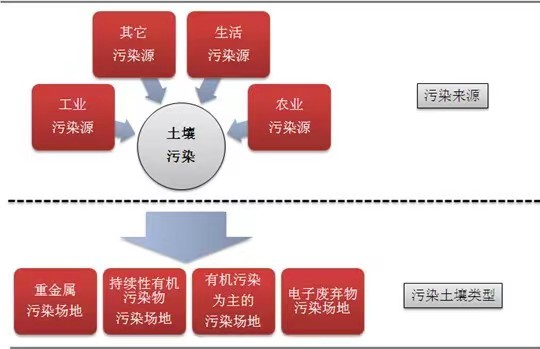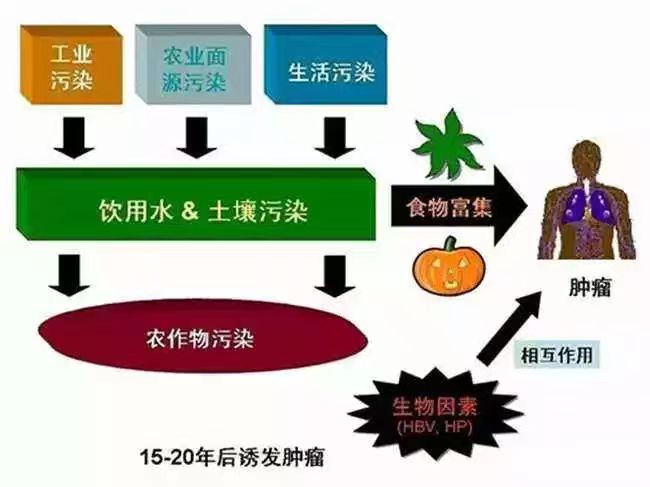
(1) Concept
The so-called heavy metal pollution of rural land refers to the fact that during the development and utilization of heavy metals and their compounds, the content of heavy metals in the soil environment of the land increases due to various reasons, and its background value has exceeded the natural environment, resulting in the destruction of soil environmental quality and the formation of soil pollution, unsafe agricultural products and poisoned organisms. When heavy metals pollute rural land, it will reduce the capacity of soil itself, and it will be absorbed into agricultural products by means of crop roots, which has a serious impact on the quality of agricultural products. Ingested into the human body through the food chain, causing harm to human health, and allowing its development leads to the serious consequences of the degradation of the entire ecosystem.
(2)Causes

1. Atmospheric subsidence: industrial production, automobile exhaust emissions, etc., produce a large number of harmful gases and dust containing heavy metals, which enter the soil through natural settlement and rain settlement.
2. Solid waste: industrial production, domestic waste and other solid waste accumulation, through leaching, erosion and other ways into the soil.
3. Agricultural production: The heavy use of pesticides and fertilizers has caused soil pollution, damaged the self-repair ability of the land, and reduced the ability of the soil to decompose heavy metals.
4. Industrial production: massive use of oil, coal, etc., discharge a large number of pollutants into the air, resulting in soil heavy metal pollution.
5. Pollution by human activities: In the overall process of urbanization, human beings have produced various kinds of pollution through the use of energy, which also caused heavy metal pollution of soil.(3)Consequeces

1. Enriched pollution

Different from the degradability of other organic compound pollutants, heavy metals gradually accumulate in the contaminated soil after the formation of soil pollution. Heavy metal elements are absorbed by crops from the soil, through the role of the food chain will magnify the toxicity of heavy metals, and in the end, it can be enriched thousands or even tens of thousands of times in higher organisms, which can lead to the transformation of highly toxic compounds, while constantly changing with the surrounding environment. Heavy metal pollutants accumulated in the soil can not only pollute groundwater by means of rainfall, leaching or infiltration, but also produce drifting effects in the atmosphere together with waste gas and dust. However, the heavy metal pollutants in any environment may eventually return to the soil through natural settlement or infiltration, and the polluted environment can form new pollution sources leading to the emergence of secondary heavy metal pollution.
2. Surface aggregation pollution

Most of the heavy metal pollutants in the soil remain in the soil ploughing layer at the same time accumulate continuously in the ploughing layer, under normal circumstances, do not migrate to the lower soil, the reason is that there are a large number of organic colloids, inorganic colloids and organic-inorganic composite colloids contained in the soil, such colloids can adsorption, substitution and biological action on the heavy metal body produced. If the heavy metal enters the soil, it can be dissolved in the soil solution, it can react with organic matter and inorganic matter in the soil, and it can be rapidly adsorbed and fixed on the surface of the soil colloid, and it is stored in the soil minerals, and other compounds in the soil have precipitation. Due to the strong adsorption and chelation ability of heavy metals in the soil colloid, the migration ability of heavy metals in the soil is limited, resulting in a large number of heavy metal pollutants in the soil cultivation layer.
3. Hidden pollution

Soil heavy metal pollution has the characteristics of colorless and tasteless, human sensory organs can not detect, usually only through the accumulation of plants into the food chain to a certain extent when the reaction may appear. Atmospheric sedimentation and water flow are the main ways for heavy metal elements to migrate and transform with heavy metal elements in soil. For people, polluted agricultural products and polluted water are absorbed, and even polluted air is absorbed, which can become a place of heavy metal enrichment. In the human body, when the accumulated concentration of heavy metals develops to a certain extent, it may produce a reaction of a certain organ or a change in a certain function of the human body, and at this time, the situation of soil pollution by heavy metals can be reflected in some form.
4. Irreversible pollution

Compared with heavy metal pollutants, soil plays a dual role as the medium of migration and transformation and the final destination. When soil heavy metal pollution is formed, it may continue to accumulate in the environment, and when it exceeds the limit value of pollutants that the soil can hold, soil heavy metal pollution will naturally occur. It is very difficult to degrade heavy metal pollution, and the heavy metal pollutants in the soil continue to accumulate, and it will be very difficult to completely restore the contaminated soil in the future. At the same time, the restoration of contaminated soil is also inseparable from a large amount of money and technology as a guarantee. For this repair work, the time required may be relatively long, even if persistent, it is difficult to achieve the goal of complete repair.